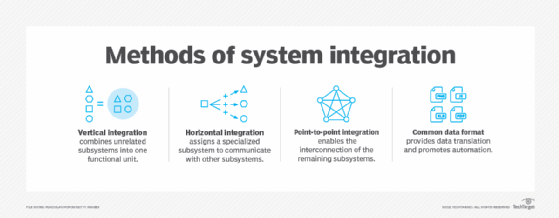integration
What is system integration?
Integration is the act of bringing together smaller components or information stored in different subsystems into a single functioning unit.
In an IT context, integration refers to the end result of a process that aims to combine different -- often disparate -- subsystems so that the data contained in each becomes part of a larger, more comprehensive system that, ideally, quickly and easily shares data when needed. This often requires organizations to build a customized architecture or structure of applications to combine new or existing hardware, software and other components.

System integration methods
There are a variety of methods for achieving connectivity between unrelated systems. Based on the type of usage and business requirements, there are four common integration methods as follows:
1. Vertical integration. This strategy enables an organization to integrate unrelated subsystems into one functional unit by creating silos based on their functionalities. Each layer or element in vertical integration works upward and the process of integration is expedited by using only a handful of vendors, partners and developers. Considered to be the quickest method of integration, it can also be the riskiest, as it requires a significant capital investment.
2. Horizontal integration. The horizontal integration method, also known as the enterprise service bus (ESB), assigns a specialized subsystem to communicate with other subsystems. It reduces the number of interfaces connecting directly to the ESB to just one, decreasing integration costs and providing flexibility. It's also considered a business expansion strategy, where one company might acquire another one from the same business line or value chain.
3. Point-to-point integration. Also commonly known as star integration or spaghetti integration, this method interconnects the remaining subsystems. Once connected, these interconnected systems resemble a star polyhedron. Most companies segment their processes during point-to-point integration. For example, a separate accounting system could track finances; a web analytics system could manage website traffic; and a customer resource management (CRM) system would integrate Salesforce. Depending on the organizational needs, data from each system could be pulled and combined.
4. Common data format. The common data format helps businesses by providing data translation and promoting automation. This method was created to avoid having an adapter for every process of converting data to or from other formats of applications. For integration to take place, enterprise application integration is used, which enables the transformation of the data format of one system to be accepted by another system. A popular example of a common data format is the conversion of zip codes to city names by merging objects from one application or database to another.
Benefits of system integration
Integrations of all types are beneficial whether they're conducted for CRM or enterprise resource planning (ERP).
The following are a few benefits of system integration:
- Automation and streamlining of processes. The biggest benefit of system integration is the streamlining and aggregation of relevant and correlated data. This helps with automating and simplifying data collection and processing of data across the different subsystems.
- Improved accessibility and syncing of data. Due to the streamlined processes, users don't have to wait for the data to be manually synced up across multiple systems to access it. For example, if one subsystem makes a data change, it's automatically updated for other systems as well. This improves the accessibility and real-time availability of data.
- Improved data accuracy. The accuracy of data is improved. Since all data is automatically updated and synchronized between disparate subsystems, the chances of inaccuracy are reduced, as users no longer access outdated data.
- Increased efficiency and revenue. System integration automates the flow of information between systems, eliminating the need for repetitive and manual data entry. This enables users to allocate their time and resources wisely and improve their overall efficiency. It also helps with increased revenue potential. For example, in the healthcare industry, an integrated payment system opens up more channels for payment collection at every patient interaction.
- Scalability. Most integrated systems rely heavily on the cloud for data storage, which makes business scalability less of a challenge. Instead of having a separate computing platform for each subsystem, integrated systems enable all subsystems to use a centralized storage platform, thus eliminating the need for replication of resources. If a business grows exponentially and additional storage is required, it can be quickly scaled up by the cloud provider.
- Cost effective. With an integration platform, companies don't need to exhaust their financial resources to manage individual subsystems and software applications and accrue extra maintenance costs. Integrated systems also eliminate repetitive tasks and eradicate the need for multiple data stores, which drastically cuts down on data storage costs.
Challenges of system integration
System integration is an intricate process. Even with the best strategies in place and a multitude of resources at a company's disposal, things don't always go as planned.
The following are common challenges of system integration:
- Legacy systems. Organizations that have been around for a while tend to have legacy systems in place that are critical to their business processes and can't be replaced easily. The challenges to achieving integration mostly have to do with the inherent difficulties of linking a series of diverse and monolithic existing systems that could be produced by multiple different manufacturers. Other integration challenges can include a lack of a coherent or unifying data structure linking all of the different systems, an unwieldy framework of multiple different applications and support systems, the sheer age of the different systems and the actual delivery of the information to key business units that need it. These data integration challenges hinder overall process efficiency because poor data exchange between systems prevents quick communication among business units.
- Rapid changes in the integration landscape. The IT and information systems landscapes are dynamic and constantly evolving. When it comes to system integrations with rapidly changing requirements, time is of the essence. System integration projects that take longer than expected tend to get complex and difficult to pursue. In a dynamic environment, the best approach is to go with an agile working strategy with short-term, ad hoc objectives that slowly build toward full integration by linking various subsystems where necessary.
- Lack of skilled resources. System integration requires a certain expertise, such as an extensive understanding of the technology industry and the latest trends, as well as a strong command of programming languages and system codes. Even if organizations have top-notch integration technology in place, they also need integration experts who have the knowledge and required integration skills. While most companies struggle to find and retain employees with such skill sets, some hire external contractors that might fall short of expertise.
- Lack of accountability. System integration involves various subsystems and multiple stakeholders, including vendors and system owners, none of whom are responsible for the entire integration process. Each involved party only takes care of their side of the integration and doesn't offer accountability if something outside their territory goes wrong. This ambiguity over ownership of different subsystems can cause serious issues with accountability during system integrations and can cause project interruptions and setbacks.
- Picking the right integration tool. From cloud to hybrid options, there's an overabundance of systems integration tools available on the market. This can make it challenging for businesses to pick the right one for their needs and requirements.
Integration and CRM systems
Companies strive to integrate their CRM systems with other components of the business to help streamline the marketing and sales processes, organizing and updating customer information with the hopes of deepening customer relationships and boosting revenue and growth.
The following are some use cases and advantages of integrating CRM systems:
- The main goal of integrating a CRM system with other, smaller systems is to prevent manual data entry and save employees time by removing redundant, unnecessary or tedious steps. For example, a company might integrate its website with its marketing automation software to bring customer information directly into the CRM system. Any action a prospect takes on the website can be logged and a new record can be automatically created in the system.
- Other uses of CRM integration include integrating email systems with a CRM and automatically importing basic customer information -- such as name, company, email address and phone number -- from emails into the CRM to facilitate follow-up contacts and log a record of interactions. Integration with other CRM systems is a key component of product development, as companies must make their products compatible with existing products to cater to the customer and maximize their reach and applicability. This often involves altering the new product's programming code to match the existing product's code so that integration can take place. Integration during product development also refers to the process in which separately produced components are combined and problems in their interactions are addressed.
- Companies will often try to integrate their CRM system with their legacy ERP or accounting systems to link financial information to assist customer service. Some integration touchpoints can be handled by the default functionality within the software packages themselves, but some configuration still needs to take place. Custom functionality might need to be built in, depending on the business's needs and the limitations of both systems.
The future of system integration
System integration plays a vital role in producing efficient workflows. With the increasing data volumes and the growing adoption of cloud computing, system integration will continue to see an upward trend in the future.
According to the Digital Journal, the global system integration market is expected to reach $222.4 million (USD) by 2026, at a compound annual growth rate of 9.4% between 2021-2026.
To deploy or connect software that exists on different platforms, integration platform as a service (iPaaS) can help. Find out when it's a good idea to use iPaaS and how to plan for it.







